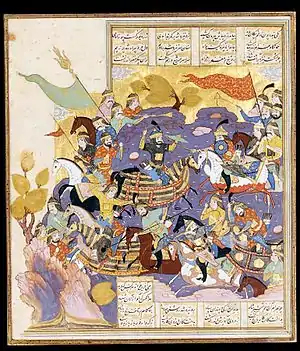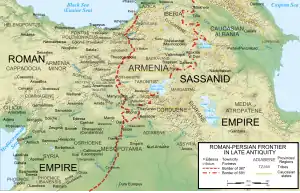Battle of the Blarathon
The Battle of the Blarathon, also known as the Battle of Ganzak, was fought in 591 near Ganzak between a combined Byzantine–Persian force and a Persian army led by the usurper Bahram Chobin.
| Battle of the Blarathon | |||||||
|---|---|---|---|---|---|---|---|
| Part of the Sasanian civil war of 589-591, Byzantine–Sassanid War of 572–591 | |||||||
 A Shahnameh illustration depicting the battle between Khusrau II and Bahram Chobin | |||||||
| |||||||
| Belligerents | |||||||
|
Khosrau II's forces | Usurper forces of Bahram Chobin | ||||||
| Commanders and leaders | |||||||
|
John Mystacon Narses Khosrau II Musel II Mamikonian Vistahm Vinduyih | Bahram Chobin | ||||||
| Strength | |||||||
|
60,000 in total | Heavily outnumbered[1] | ||||||
| Casualties and losses | |||||||
| Unknown | Unknown | ||||||
Overview

The combined army was led by John Mystacon, Narses, and the Persian king Khosrau II. The Byzantine–Persian force was victorious, ousting Bahram Chobin from power and reinstating Khosrau as ruler of the Sassanid Empire. Khosrau was swiftly reinstated upon the Persian throne, and as agreed upon returned Dara and Martyropolis. Additionally, he agreed to a new partition of the Caucasus by which the Sassanids handed over to the Romans many cities, including Tigranokert, Armavir (Armaouira), Manzikert, Baguana, Valarsakert, Bagaran, Vardkesavan, Yerevan, Ani, Kars, and Zarisat. Most of the Kingdom of Iberia, including the cities of Ardahan, Lori, Dmanisi, Lomsia, Mtskheta, and Tontio became Roman dependencies. Also, the city of Cytaea was given to Lazica, also a Roman dependency. The Battle of the Blarathon altered the course of Roman-Persian relations dramatically, leaving the former in the dominant position. The extent of effective Roman control in the Caucasus reached its zenith historically.
References
- "Bahrām VI Čōbīn – Encyclopaedia Iranica". www.iranicaonline.org.
- Pourshariati (2008), pp. 127–128
Sources
- Whitby, Michael (1998), The Emperor Maurice and his Historian – Theophylact Simocatta on Persian and Balkan Warfare, Oxford University Press, ISBN 0-19-822945-3
- Pourshariati, Parvaneh (2008). Decline and Fall of the Sasanian Empire: The Sasanian-Parthian Confederacy and the Arab Conquest of Iran. London and New York: I.B. Tauris. ISBN 978-1-84511-645-3.